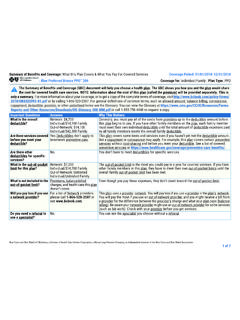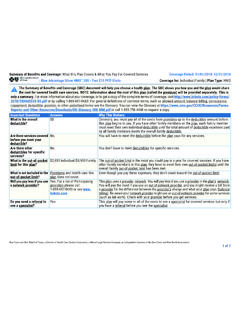Transcription of PrenatalCare Plan
1 Prenatal Care plan Alberta Medical Association, October 2000. Index Introduction 2. Prenatal Worksheet Sample 3. Preconception Visit 4. History and Physical 4. Investigations 5. Counseling 6. First Antenatal Visit 8. History and Physical 8. Investigations 9. Counseling 10. Routine Antenatal Visit 12. History and Physical 12. Investigations 12. Counseling 13. Neonatal Care 14. Postpartum Visit 14. History and Physical 14. Investigations 15. Counseling 15. Additional Resources 16. References 17. Prenatal Worksheets 19 & 21. Introduction This document is intended as a guide to comprehensive prenatal care for the women of Alberta. It is suitable for use by obstetricians, family physicians and midwives. This care plan is not meant to replace clinical judgment, especially for women with significant risk factors or unusual circumstances. Certain investigations should only be performed if deemed appropriate by the attending physician/midwife. Note that separate guidelines may also be available for some of the items.
2 Please forward any comments or questions to the Committee on Reproductive Care, Alberta Medical Association. Committee on Reproductive Care Dr. Carolyn A. Lane Dr. Stuart J. Iglesias Dr. Duncan J. McCubbin Dr. Douglas D. McMillan Dr. Reginald S. Sauve Dr. Rebecca L. Simrose Dr. Cynthia L. Trevenen Dr. Virginia J. Clark Ms Zahra M. Kassam Dr. Leonard G. Evenson Dr. Albert R. Akierman Dr. John R. Waters Dr. M. Robin Smith Ms Ann Hense Dr. Beverley O'Brien Ms Grace Guyon Dr. Nestor N. Demianczuk Dr. William R. Young 2 Prenatal Care plan Alberta Medical Association, October 2000. Prenatal Worksheet This prenatal worksheet outlines the examinations, investigations and counseling the physician or midwife should consider conducting during a woman's pregnancy. Dark purple indicates items to be considered in at-risk populations. Light purple indicates items to investigate only if evidence warrants. How to use this worksheet The physician or midwife may use this worksheet as a reference tool when providing prenatal care.
3 The form may also be completed and maintained in the patient's record. If used, this worksheet is a supplementary reference tool and cannot replace the Alberta Prenatal Record. Two additional copies of this worksheet are provided at the end of this document. The worksheets are perforated so they can be easily removed and photocopied for use as a patient record if desired. For detailed explanations about any items on the worksheet, refer to the corresponding text in this document. Prenatal Worksheet Prenatal Care plan , Alberta Medical Association, October 2000. This prenatal worksheet outlines the examinations, investigations and counseling the physician or midwife should consider conducting during a woman's pregnancy. Dark purple indicates items to be considered in at-risk populations. Light purple indicates items to investigate only if evidence warrants. TIMING HISTORY & PHYSICAL INVESTIGATIONS TO CONSIDER COUNSELING. Prior to conception Complete history & physical CBC Lifestyle issues Assess impact of current medical Carrier Screening nutrition (including folic acid supplementation).
4 Illness (diabetes, hypertension) Rubella titre sleep patterns Pap smear exercise STD screening work HIV serology smoking Other viral serology alcohol and drug use Glucose testing 6 10 weeks Review history & physical CBC Review lifestyle issues LY. Rubella titre Management of nausea if present ON Syphilis serology (RPR) Normal symptoms of pregnancy LE 21. HIV serology Genetic screening P. ABO/Rh & antibodies Sexuality M. Hepatitis B antigen Seatbelt use SA pp. 19. Urinalysis C&S Domestic violence Pap smear Prenatal classes Use Vaginal or cervical cultures Breastfeeding Other viral serology Assign EDD (Estimated Due Date). Glucose testing Review medication and herb usage At each visit Inquire as to general well-being Urine for glucose Counsel for common symptoms at this gestation (Conduct visits q4weeks up to 28-30 Assign gestational age Urine for protein weeks, q2weeks up to 36 weeks Weight and q1week until delivery) Blood pressure Symphysis-fundal height in cm Fetal heart sounds Presence of fetal movements 10 16 weeks Genetic Screening (Biochemical/Amniocentesis/CVS).
5 17 19 weeks Ultrasound Confirm EDD for entire pregnancy 18 22 weeks Preterm labour 24 28 weeks Hemoglobin Obtain VBAC consultation/ documentation Diabetic screening ABO/Rh & antibodies (if Rh negative). 28 32 weeks Add fetal position to routine visit Give Rh immune globulin (if Rh negative) Importance of fetal movement awareness 30 36 weeks Labour & delivery issues Hospital admission procedures Newborn issues and testing Breastfeeding Postpartum planning Commence fetal movement charting 36 weeks Confirm presentation of fetus GBS culture Ensure record available to L&D unit 41 42 weeks Fetal assessment Induction plans Postpartum (6 weeks) Pelvic examination Pap smear Labour & delivery issues Breastfeeding evaluation Hemoglobin Sexuality & contraception Check for postpartum depression Review Rubella status Coping strategies Prenatal Care plan Alberta Medical Association, October 2000 3. Preconception Visit All women should be offered preconception care. A preconception visit is an ideal opportunity to discuss potential problems and provide appropriate interventions before a pregnancy even begins.
6 Page one of the Alberta Prenatal Record may be a helpful framework from which to begin. History and History Physical The obstetrical, medical and family history should all be reviewed. Anything that could adversely influence the future pregnancy should be documented, investigated and treated when possible. Certain conditions, such as diabetes and hypertension, can have a profound effect on pregnancy and its management. Example 1: If the obstetrical history includes recurrent pregnancy losses, some investigations can be completed prior to conception, with appropriate interventions initiated early in pregnancy. Example 2: If the family history shows an unusual syndrome, it can be investigated pre-conception to assess the couple's risk of conceiving a child with the syndrome. This allows the couple to make informed choices in a timely manner. Example 3: A medical history of a seizure disorder and use of antiepileptic therapy can increase the risk of neural tube defect. Risk may be significantly reduced by adjusting the medication and using folic acid supplementation.
7 Note: It is not within the scope of this document to address all the significant historical factors that can influence conception and pregnancy. Each accoucheur should familiarize him/herself with factors that can lead to complications of pregnancy and delivery. Physical The preconception physical examination provides an opportunity to identify factors that are best investigated and treated prior to pregnancy. Example 1: If a thyroid nodule is detected in pregnancy, it may be difficult to determine whether the patient is euthyroid due to an alteration of thyroid indices during pregnancy. Further, the thyroid cannot be investigated or treated with radioactive iodine during pregnancy. Example 2: If detected prior to conception, a suspicious breast nodule can be investigated and removed if necessary. If chemotherapy is indicated, this can occur immediately. In contrast, a malignant breast lesion discovered in early pregnancy may force a woman to choose between terminating the pregnancy and delaying appropriate therapy.
8 4 Prenatal Care plan Alberta Medical Association, October 2000. Preconception Visit Investigations CBC. A preconception CBC may identify an iron deficiency state that could be corrected prior to conception; it may also help identify any previously undiagnosed hemoglobinopathies. MCV hemoglobin electrophoresis is the most reliable way to diagnose hemoglobinopathies. Carrier Screening Populations at risk for hemoglobinopathies should be screened with MCV . hemoglobin electrophoresis. Southeast Asians, East Indians, Blacks and Hispanics are at risk for -thalassemia. Italians, Greeks and those of Mediterranean backgrounds are considered at risk for -thalassemia. All blacks are at risk for sickle cell disease and should be offered Sickledex screening. The Ashkenazi Jewish population is at risk for Tay Sachs Disease and should be offered the benefit of genetic counseling. Rubella titre Any non-immune woman can receive appropriate immunization prior to conception. Any positive titre within the preceding 10 years is sufficient to indicate current immunity.
9 Pap smear Significant abnormalities should be treated prior to conception. STD screening It may be appropriate to perform STD (sexually transmitted disease). screening at the preconception visit. Some STDs can lead to infertility and should therefore be treated upon detection. Once a woman is pregnant, she or her physician may be reticent to use certain pharmaceutical agents due to their potential impact on the fetus. In many instances, treatment prior to pregnancy is preferable. HIV serology Patients who do not consider themselves at risk of being HIV (Human Immunodeficiency Virus) positive may still be infected. With appropriate counseling, determining HIV status may be an important factor in considering whether or not to conceive. Other viral serology Some patients may be at risk of exposure to certain viral agents and may benefit from determining their immune status prior to conception. Examples include the mother of a preschool infant who is uncertain if she has had chicken pox; the childcare worker who worries about CMV (cytomegalovirus).
10 And the veterinarian who is concerned about toxoplasmosis. Glucose Testing Glucose testing may be indicated in women with a higher risk of diabetes. Since overt diabetes carries an increased risk of fetal anomaly, it is best to identify and treat the condition prior to conception. Prenatal Care plan Alberta Medical Association, October 2000 5. Preconception Visit Counseling Nutrition and vitamins Women should be encouraged to eat a well balanced diet with calories and food groups spread evenly throughout the day. The Canada Food Guide is a good reference and educational tool. Encourage obese patients to eat well and to move closer to their ideal body weight by increasing exercise and avoiding excessive fat intake. All women should be counseled to take folic acid supplementation of mg/day for at least a month prior to conception and for the first 12 weeks of pregnancy. Women at increased risk of giving birth to a child with a neural tube defect should take 4 5 mg of folic acid supplementation daily.



